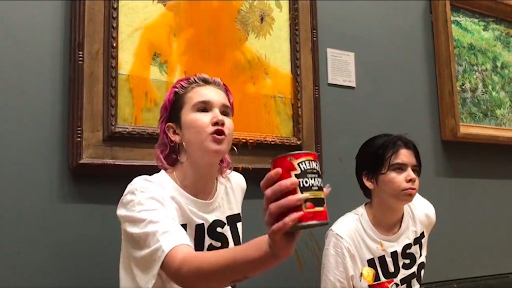Mortification and a malfunctioned campaign
What could motivate someone to try and destroy a work of art? One may imagine that art vandals must be suffering from some form of mental illness, however, past events have proved that this is not the case. In many instances, the pieces are targeted for a reason – usually for the offender’s political protests to achieve recognition in the headlines. As a matter of fact, many have succeeded in exposing themselves, but trashing a cultural treasure has never changed public policy.
The tragedy of the tomato soup
Climate change protests have been a collective effort, and several groups of protestors have risen to promote their views. An example of this is the climate activist group called “Just Stop Oil”. It defines itself as a group committed to ensuring the government ends the development and production of fossil fuels in the UK. Their throwing of tomato soup on a priceless piece of art in mid-October was a symbolic resistance against rising oil prices. A protestor stated, “fuel is unaffordable to millions of cold, hungry families who can’t even afford to heat a tin of soup”. This may be true, but they missed one unavoidable fact: when a protest group with strong public support turns violent, the general public perceives them as less reasonable. In turn, this leads to people becoming less supportive, according to a new study by Stanford sociologist Robb Willer.

Art or life?
Two anti-fossil fuel protests, both members of “Just Stop Oil,” were charged with criminal damage offences for throwing canned Heinz tomato soup on Van Gogh’s iconic artwork, “Sunflowers.” The protestors refused to cease their insensitive act and later on glued themselves to the wall. “What is worth more, art or life?” said one of the protesters, Phoebe Plummer, 21. “Are you more concerned about the protection of a painting or the protection of our planet and people?” The National Gallery informed us about the condition of the painting, announcing, “there is some minor damage to the frame, but the painting is unharmed.” Furthermore, the gallery added that the piece was glazed for protection from any other potential threat.
The big ban
At the end of the day, what can be done to prevent further outbursts? The galleries should tackle the issue that minimised these incidents while ensuring the protection of the art pieces. This is certainly not an easy task to fulfil as museums, galleries, and other platforms allow access to art pieces to all people. As a result, physical security measures providing restricted access are believed to be an inefficient solution, as several vandals have bypassed it. This is tackled by the authorities to take more functional methods like German museum associations strictly denouncing the protests that took place, and Berlin’s state-run museums forbidding visitors from bringing bags into their galleries to avoid potential damage. In addition, a heavy sentence of two months in prison had been declared to the activists in a court in the Netherlands as a punishment as well as a warning to any future action taken by them.

The faint future
At the time of the protests, the cost of fuel was drastically lower than the months before, which led to higher consumption rates. This caused the protestors to take such drastic actions due to their concern as to how such high fuel consumption rates would impact the environment. Recently, however, the prices began to rise once again. What will this lead the protesters to do? Will they continue to make their point by vandalising even more iconic and valuable paintings? Will this madness stop?


